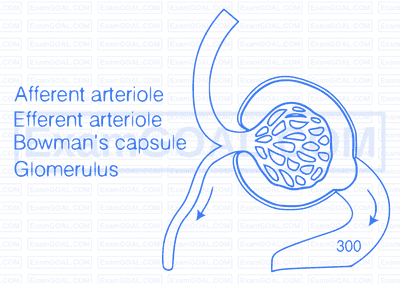MCQ Single Correct
1
The following substances are the excretory products in animals. Choose the least toxic form among them.
2
Filtration of the blood takes place at
3
Which of the following statement is incorrect?
4
A large quantity of one of the following is removed from our body by lungs.
5
The pH of human urine is approximately?
6
Different types of excretory structures and animals are given below. Match them appropriately and mark the correct answer from among those given below
| Excretory Structure/Organ | Animals | ||
|---|---|---|---|
| A. | Protonephridia | 1. | Prawn |
| B. | Nephridia | 2. | Cockroach |
| C. | Malpighian tubules | 3. | Earthworm |
| D. | Green gland or antennal gland | 4. | Flatworms |
7
Which one of the following statements is incorrect?
8
Which of the following pairs is wrong?
9
Which one of the following statement is incorrect?
10
The condition of accumulation of urea in the blood is termed as
11
Which one of the following is also known as antidiuretic hormone?
12
Match the following columns.
| Column I | Column II | ||
|---|---|---|---|
| A. | Proximal convoluted tubule | 1. | Formation of concentrated urine |
| B. | Distal convoluted tubule | 2. | Filtration of blood |
| C. | Henle's loop | 3. | Reabsorption of 70-80% of electrolytes |
| D. | Counter current mechanisms | 4. | Ionic balance |
| E. | Renal corpuscle | 5. | Maintenance of concentration gradient in medulla. |
13
Match the following columns.
| Column I | Column II | ||
|---|---|---|---|
| A. | Glycosurea | 1. | Accumulation of uric acid in joints |
| B. | Renal calculi | 2. | Inflammation of glomeruli |
| C. | Glomerular nephritis | 3. | Mass of crystallised salts within the kidney |
| D. | Gout | 4. | Presence of glucose in urine |
14
We can produce a concentrated/dilute urine. This is facilitated by a special mechanism. Identify the mechanism.
15
Dialysing unit (artificial kidney) contains a fluid which is almost same as plasma except that it has
subjective-very-short
16
Where does the selective reabsorption of glomerular filtrate take place?
17
What is the excretory product from kidneys of reptiles?
18
What is the composition of sweat produced by sweat glands?
19
Identify the glands that perform the excretory function in prawns.
20
What is the excretory structure in Amoeba?
21
The following abbreviations are used in the context of excretory functions, what do they stand for?
(a) ANF (b) ADH (b) GFR (d) DCT
22
Differentiate glycosuria from ketonuria.
23
What is the role of sebaceous glands?
24
Name two actively transported substances in glomerular filtrate.
25
Mention any two metabolic disorders, which can be diagnosed by analysis of urine.
26
What are the main processes of urine formation?
27
Sort the following into actively or passively transported substances during reabsorption of GFR. e.g., glucose, amino acids, nitrogenous wastes, $\mathrm{Na}^{+}$, water.
28
Complete the following
(a) Urinary excretion $=$ tubular reabsorption + tubular secretion -
(b) Dialysis fluid = plasma -
29
Mention the substances that exit from the tubules in order to maintain a concentration gradient in the medullary interstitium.
30
Fill in the blanks appropriately
| Organ | Excretory wastes | |
|---|---|---|
| (a) | Kidneys | ...................... |
| (b) | Lungs | ..................... |
| (c) | Liver | .................... |
| (d) | Skin | .................... |
subjective-short
31
Show the structure of a renal corpuscle with the help of a diagram.
32
What is the role played by renin-angiotensin in the regulation of kidney function?
33
Aquatic animals generally are ammonotelic in nature where as terrestrial forms are not. Comment.
34
The composition of glomerular filtrate and urine is not same. Comment.
35
What is the procedure advised for the correction of extreme renal failure? Give a brief account of it.
36
How have the terrestrial organisms adapted themselves for conservation of water?
37
Label the parts in the following figure.

38
Explain, why a haemodialysing unit called artificial kidney?
39
Comment upon the hormonal regulation of selective reabsorption.
subjective-long
40
Explain the mechanism of formation of concentrated urine in mammals.
41
Draw a labelled diagram showing reabsorption and secretion of major substances at different parts of the nephron.
42
Explain briefly, micturition and disorders of the excretory system.
43
How does tubular secretion help in maintaining ionic and acid-base balance in body-fluids?
44
The glomerular filtrate in the loop of Henle gets concentrated in the descending and then gets diluted in the ascending limbs. Explain.
45
Describe the structure of a human kidney with the help of a labelled diagram.